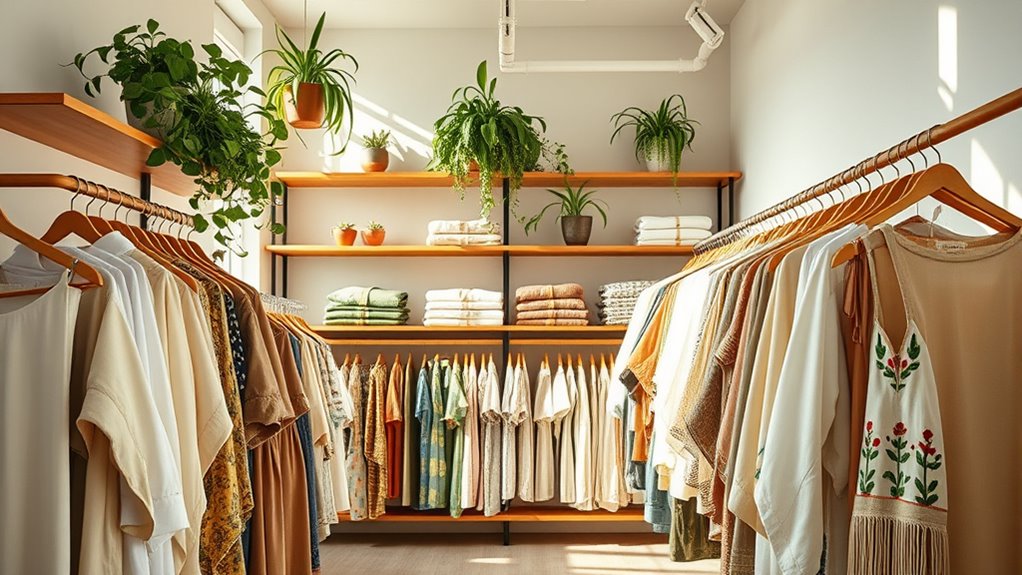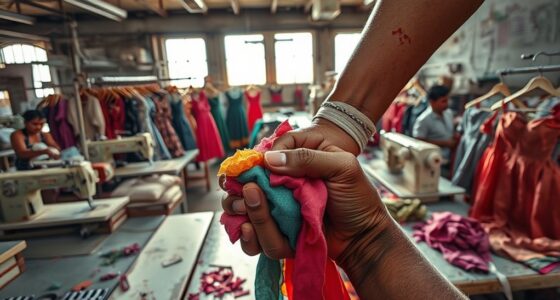Several fashion brands now prioritize sustainability by becoming carbon negative, meaning they pull more carbon from the atmosphere than they emit. You can support companies like Allbirds, Patagonia, and Toms, which invest in renewable energy, reforestation, and eco-friendly materials. These brands prove that fashion can be stylish and environmentally responsible. If you keep exploring, you’ll discover how these visionary companies are reshaping the industry for a greener future.
Key Takeaways
- Many brands are achieving carbon-negative status by offsetting more emissions than they produce through renewable energy, reforestation, and carbon capture initiatives.
- These brands prioritize sustainable materials like organic cotton, hemp, and recycled fabrics to reduce environmental impact.
- They use eco-friendly packaging solutions such as biodegradable wraps and recycled boxes to minimize waste and plastic pollution.
- Transparency in supply chains and publishing sustainability reports demonstrate accountability and commitment to environmental goals.
- Supporting carbon-negative fashion brands helps consumers promote eco-conscious practices and contribute to combating climate change.

Many fashion brands are now taking bold steps to reduce their environmental impact, with some even going beyond neutrality to become carbon negative. If you’re passionate about supporting brands that prioritize sustainability, you’ll want to pay attention to how they approach sustainable material sourcing. These companies are actively seeking out eco-friendly fabrics like organic cotton, hemp, recycled polyester, and Tencel, which are produced with fewer chemicals and lower water usage. By choosing such materials, they lessen the reliance on virgin resources and cut down on greenhouse gas emissions from production. This shift not only reduces their carbon footprint but also promotes a circular economy where waste is minimized.
Beyond sourcing sustainable materials, these brands are also revolutionizing their packaging practices. Eco friendly packaging is becoming a standard, not an exception, as they move away from single-use plastics and non-biodegradable materials. Instead, they opt for biodegradable wraps, recycled boxes, and compostable bags that don’t harm the environment. This commitment to sustainable packaging shows that every touchpoint in the supply chain is being rethought to lessen environmental harm. As a consumer, you can feel good knowing that your purchases are not contributing to plastic pollution or landfill waste.
Some brands go even further by implementing transparent supply chains, ensuring that every step — from raw material extraction to final delivery — adheres to environmental and social standards. They often publish detailed sustainability reports, so you can see how much carbon they’ve offset or reduced through various initiatives. These efforts include investing in renewable energy, reforestation projects, and carbon capture technologies, which help them achieve a carbon-negative status. When you buy from these brands, you’re supporting a system that actively pulls more carbon out of the atmosphere than it emits.
Supporting carbon-negative fashion brands means aligning your values with your purchasing decisions. It’s about demanding accountability and encouraging others in the industry to follow suit. You don’t have to compromise on style or quality—these brands prove that eco-conscious fashion can be both trendy and responsible. By choosing brands that prioritize sustainable material sourcing and eco friendly packaging, you’re contributing to a more sustainable future. Every small purchase can make a difference, especially when it’s part of a larger movement toward reducing the fashion industry’s environmental footprint. In doing so, you’re helping create a world where fashion is not just about looking good but also about doing good for the planet.
Frequently Asked Questions
How Do Carbon-Negative Brands Verify Their Environmental Claims?
You might wonder how carbon-negative brands verify their environmental claims. They typically ensure supply chain transparency by tracking emissions throughout production. They also rely on third-party certification to validate their claims, providing credibility and accountability. These processes help confirm that the brand genuinely offsets more carbon than it emits, giving you confidence in their sustainability efforts. This rigorous verification is vital for maintaining trust and demonstrating real environmental impact.
What Materials Are Commonly Used by Carbon-Negative Fashion Brands?
Did you know that over 60% of carbon-negative brands use sustainable textiles? You’ll find materials like organic cotton, hemp, and Tencel, which are eco-friendly choices. These brands also favor eco-friendly dyes that reduce chemical pollution. By choosing these materials, you actively support environmental health. So, when shopping, look for these sustainable textiles and eco dyes to make a positive impact on the planet.
Can Small Brands Achieve Carbon Negativity Effectively?
You can definitely achieve carbon negativity as a small brand by focusing on sustainable supply chains and innovative recycling methods. By sourcing eco-friendly materials and minimizing waste through creative reuse, you reduce your carbon footprint. Engaging with local suppliers and adopting transparent practices help maintain sustainability. Small brands have the agility to implement these strategies effectively, making a meaningful impact on the environment while building a loyal, eco-conscious customer base.
How Do Consumers Support Carbon-Negative Fashion Brands?
Imagine your shopping bag bursting into a rainbow of eco-friendly choices—that’s what supporting carbon-negative fashion brands feels like! By choosing sustainable shopping and practicing ethical consumerism, you help turn the industry green and clean. Every purchase sends a powerful message, encouraging brands to prioritize sustainability. So, shop consciously, spread awareness, and become a champion of the planet—your choices can truly make a difference in creating a greener future.
Are Carbon-Negative Brands More Expensive Than Traditional Brands?
You might notice that carbon-negative brands often have a higher price premium than traditional brands, mainly due to sustainable materials and ethical practices. This price difference can influence brand perception, making these brands seem more exclusive and eco-conscious. Although you may pay more upfront, supporting these brands aligns with your values and helps promote environmental responsibility in fashion. Ultimately, your purchase supports a more sustainable industry.
Conclusion
By supporting these carbon-negative fashion brands, you’re not just making a statement—you’re planting seeds for a greener future. Think of your choices as a ripple in a vast ocean, capable of transforming the industry one sustainable step at a time. Every garment you wear from these brands helps turn the tide against climate change. So, embrace these eco-friendly options and let your wardrobe be a beacon of hope in a world craving change.









